
CHICAGO—A group of public REITs has dominated the self-storage investment market for years, but recently a swarm of new players made their mark. Private buyers now win many of the bids, and experts say this shift in the investment landscape will probably last a long time, even though revenue growth, while steady, has slowed down somewhat.
“Historically, the amount of annual revenue growth has been around 4%,” Marc Boorstein, a principal with Chicago-based self-storage firm MJ Partners, tells GlobeSt.com, and sometimes up to 7% or 8%. His firm just released its latest quarterly analysis of the self-storage sector and finds that the major REITs generated same-store revenue growth in the first quarter ranging from 2.1% to 5.2%. But with better management techniques and scale, most of the big players have also maintained occupancy levels of more than 90%. Just a few years ago, these firms were in the low 80s. “They are definitely holding their own.”
Public Storage, by far the largest REIT in the industry, also saw the lowest growth rate. Boorstein says with 2,615 facilities in the US and Europe, nearly double its nearest rival, it competes in more markets and serves many new customers that might resist steep rental increases. By contrast, National Storage Affiliates, the newest and smallest of the big five, competes in far fewer markets and saw revenue growth of 4.2%.
Public Storage is the only REIT that still has a robust development pipeline, currently at about $662 million. But like its counterparts, it has also responded to slower revenue growth by slowing down the rate of wholly-owned acquisitions. As reported in GlobeSt., it recently expanded its third-party management platform to directly compete with other major REITs such as Extra Space Storage, CubeSmart and LifeStorage. The firms increasingly expect to acquire properties through off-market opportunities originating with third-party management relationships.
However, “it takes time to build these up,” Boorstein says. The industry is still dominated by thousands of small operators, and these owners may hold off selling for several years.
But as the REITs pulled back on acquisitions, private capital stepped up.
“There is more private capital chasing self-storage than ever before,” Boorstein says. Private buyers, mostly institutional-backed private equity, in addition to a growing number of family offices, see a sector that has experienced steady growth in demand for years, and not just in gateway cities. As a result, in nearly all markets, including secondary and tertiary markets, private capital is aggressively bidding for self-storage assets, even older properties.
“The cap rates on acquisitions have not moved in the last year,” Boorstein says, even though the REITs have slowed down their buying. Sometimes, his firm will handle a sale and get 15 offers, “and 13 will be private, and just two from the public REITs, and they aren't winning the bids anymore.”
© Touchpoint Markets, All Rights Reserved. Request academic re-use from www.copyright.com. All other uses, submit a request to [email protected]. For more inforrmation visit Asset & Logo Licensing.







